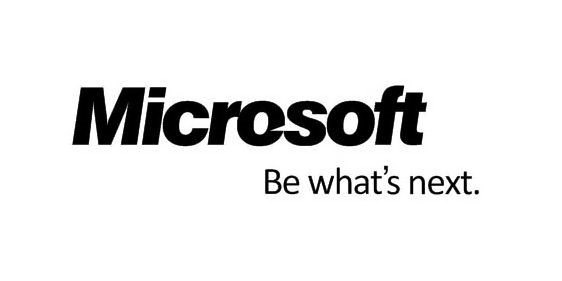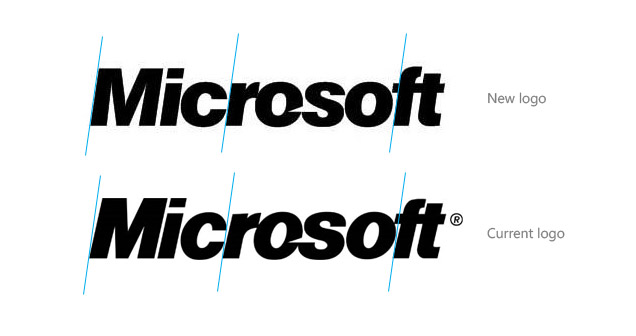
After it made its blurrycam debut from an internal employee-only event less than half a year ago, the new Microsoft corporate tagline “Be what’s next” is now in the final stages of brand christening as an updated wordmark was just filed to the trademark office earlier this week.
Although Microsoft spokespeople has already confirmed the legitimacy of the tagline shortly after it was leaked, it hasn’t made much of an appearance since. Speaking of which, even Microsoft’s current tagline “your potential, our passion” has faded from the public eyes over the years. The last time I recall it appeared anywhere was in the series of “We see” TV ads Microsoft aired years ago.
With the new year quickly approaching, I hope we’ll see much more of the tagline if not a broader brand refresh in 2011.
P.S. The font of the new tagline doesn’t seem to use Segoe but is Helvetica Franklin Gothic like the rest of the Microsoft logo itself.
Update: Twitter user @JaycobC also notes that the new Microsoft logo is actually less slanted than the current one. With some CSI-like forensics analysis, I can confirm this is indeed the case.

Microsoft should really be “what’s next”, not just create a tagline. Tagline is too bureaucratic, and doesn’t reflect real feelings inside the company IMHO.
Still, to have something “real” instead of that tagline, Microsoft needs to have an exceptionally great technical visionary leader. Like Bill Gates, or Sergey Brin, or Larry Page – a someone who will set up a high-level mission, and will build a company, its organization around that mission; will build up an organization around a shared dream.
Eventually, not around money but around dream. Of course there will be money inside, but the big dream will attract great people. No big dream – no great people – no great results.
Microsoft is full of insanely talented and under appreciated people.
And Steve might come off a little nutty but he is pretty much the industry’s smartest company leader. Keep in mind that since the departure of Bill, he has brought to the company Windows 7, Xbox, Bing, Zune and Windows Phone 7, all of which will be (or are already) billion dollar businesses in their own right.
First of all this is not a Bill Gates flame but if you knew the real history of Microsoft you would know that Bill’s only real genius moment was forcing PC manufactures to pay a license to MS whether they sold the box with MS DOS or not. Bill’s dad was the first genius of MS for telling Bill to license DOS to IBM and not sell it. After that you’d have to put an unheralded Jon Shirley on that list an early COO who often told Bill to shutup and leave meetings because Bill was disruptive and didn’t trust anyone who wasn’t a programmer.
Gates really is the accidental billionaire and no visionary. I remember Jobs had once said that the problem with Bill Gates was that he had no taste. I think that showed in Windows right through to Vista. Windows Mobile 7 is quite attractive. Bill would never have come up with that.
I mentioned nothing about Bill. I do agree with you to some extent that Bill accidentally became as rich as he is. But Bill is a visionary today as a philanthropist, for sure. The stuff he is doing is amazing. Bill never needed taste. He just employed people who do have it.
Font used in Microsoft logo is NOT Helvetica. It’s modified version of Franklin Gothic. And tagline also is not Helvetica!
Thanks for the correction. 🙂
Speaking of the logo, is there a reason there is a chip in the ‘o’? Any symbolic reason?
From Wikipedia:
Microsoft adopted the so-called “Pac-Man Logo”, designed by Scott Baker, in 1987. Baker stated “The new logo, in Helvetica italic typeface, has a slash between the o and s to emphasize the “soft” part of the name and convey motion and speed.”
ehm YES it IS Helvetica!!!!
The tag-line doesn’t work for me. My mind thinks “next what?”, and since it’s advertising from a massive corporation I can’t help but put a cynical spin on it.
I realise they mean “next big thing” but I can’t stop thinking of it in the context of “who’s next?” (after the person saying it beat-up the first guy and wants to know who wants some more) or “you’re all f***ing next!” (from Jay & Silent Bob :)). “Next victim”, “next into the fire”, “next under the steamroller”…
Simply being next does not imply something good is about to happen to you.
Maybe it’s just me. 🙂 Marketing tag-lines probably aren’t aimed at me.
How about:
“Microsoft: Our CEO is a ****ing **** but not as much of one as Steve Jobs or Larry Ellison”
That’s why *I* prefer the company to other similar offerings, at least.
don’t get it … why don’t they just say Microsoft. Seriously dead simple. Use your company name. Then communicate what your stand for via your actions.
You don’t read McDonalds… burgers for the masses? No. You read McDonalds… no questions asked. You know what you get… consistent burgers that are not awesome but fill your up when you don’t have another option for food.
No. You read: McDonald’s. I’m lovin’ it.
Pretty much every company has a tag-line and there’s nothing wrong with it.
So many haters here.. I personally think that it’s a great tagline; straight, to the point, and ambitious. It reinforces the message that Microsoft is providing the tools for people to innovate for the future.
I have never seen marketing of any kind discussed on the Internet without some nerd bitching about it from the perspective of his almost-libarts degree and a bottom feeder job somewhere in IT.
Their inability to understand marketing–communications–making eye contact with people–is part of why they are upset about things like logos or taglines.
“Almost-libarts degree and a bottom feeder job somewhere in IT”
If you’re talking about me, I did a computing degree at (arguably) the best university in the UK and my career has been developing things like risk-management platforms for major investment banks.
Marketing isn’t about making eye contact with people; at this level it’s about tricking people into believing your message and buying your product/brand.
If you’re not cynical about marketing you’re an idiot.
If you want to judge marketing on how well it’s tricking people, go for it, but at least be honest about it.
look at this angry nerd
your life must be depressing
There have been reports on the Internet that Windows 8 could be called Windows “next”. Might just be an internal code name. However, the two appear to be related.
Can Microsoft really be what’s next? It’s a reactive company, it follows. It doesn’t lead the way. They are usually clueless about the next best thing but quick to copy if something succeeds.
Unfortunaly, “be what’s next” will mean “be something awesome we have in research that Google makes an actual product out of two years later.”
Looks like they’re straightening themselves.
Lmfao..
I kinda like it, seems more enjoyable to read, and the new tagline have more potential than the crappy old one. Its actually kind of engaging, calling for action. Really nice!
What’s next for Microsoft? extinction.
Be what’s next? be a fading memory, like an unpleasant smell just before the window is opened to let in some fresh air.
Yikes! Could this be as bad as “Chevy Runs Deep” or “Lean Forward?” At least “Be What’s Next” is much more dynamic, even though it doesn’t apply in the least to Microsoft’s spotty record as an innovator! See more: http://wp.me/pIfvI-su
The slogan reminds me of Hitachi’s: Inspire the Next.
Being what’s next is working for me big time because it implies the company is deciding to strategically change its tactics.
Following competition into a market 2-3 years afterwards combined with their infamous not getting it right until version 3.0 resulting in an aggregate six year product design life cycle is no longer sustainable.
Being what’s next means deciding to take innovate and step into the spotlight as the rock stars of software design and development that the company and all of its people are all about.
Not be be perceived as the fanboy, Microsoft just ran off Ray Ozzie who was and is a guy who has always been about what’s next and the company remains controlled by Steve Ballmer, a guy everybody knows is all about what used to be; that being Ballmer’s highest and best use being the enterprise market strategies and tactics which do not work with contemporary consumer markets which require being what’s next.
Gee! What’s next? To be or not to be….